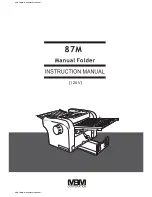
Operating Instructions
Page 6-10
©2004 General Binding Corporation
S
IGN
M
AKER
25/44
SPEED/TEMPERATURE GUIDE AND THE
ART OF LAMINATION
Do not attempt to laminate abrasive or metal objects such as
staples, paper clips and glitter, as they may damage the heat or
pull rollers.
Do not force items into the nip area of the heat rollers. An item that
is not easily drawn into the laminator by the heat rollers is probably
too thick to laminate.
Wrinkles may result if an attempt is made to reposition an item once
it has been grasped by the heat rollers.
Do not stop the laminator before an item has completely exited the
pull rollers. Even a momentary stop will cause a mark (heat line)
on the laminated item.
Good, consistent lamination is a result of combining proper heat, tension
and dwell time. Dwell time is controlled by the speed of the motor and is
defined as the amount of time the material to be laminated is compressed
between the heat rollers. When one of the film gauge buttons is selected
the laminator automatically sets the speed and temperature for that film
and 20 lb. paper (copier paper).
As a general rule, thicker items and film need to run at slower speeds
because they extract more heat from the rollers at a quicker rate. Setting
the speed control at slower settings gives the laminator longer dwell time
thus allowing proper lamination of thick items. Thinner items, such as
standard copier paper (20 lb. bond) and tissue paper, extract less heat
from the rollers and can be run at faster speeds.
Operation of the laminator for more than thirty minutes at a time may
necessitate a lower speed setting. It is recommended that, during periods
of long runs, the items being laminated are alternated between thick and
thin. Do not combine thick and thin items at the same time, as this will
result in a poor edge seal around the thinner material. If you are unsure
that the laminator is set at the proper speed for the item to be laminated,
run a test piece (scrap) of the same or similar material through the
laminator. This procedure is recommended because rotating the heat
roller prior to lamination will more evenly distribute the heat. Make speed
adjustments if necessary.
The SignMaker Series Lamination guide provides general guidelines
for suggested heat and speed settings to use with certain material and
laminating film combinations. A guide is located on the left side cover
of the unit and in this manual. This is only a general reference guide.
Different settings may be suitable as the warm up time, lamination time
and materials change.
Summary of Contents for GBC SignMaker 25
Page 4: ...Operating Instructions Page ii 2004 General Binding Corporation SIGNMAKER 25 44...
Page 6: ...Operating Instructions iv 2004 General Binding Corporation SIGNMAKER 25 44...
Page 10: ...Operating Instructions Page 2 2 2004 General Binding Corporation SIGNMAKER 25 44...
Page 11: ......
Page 12: ...Operating Instructions Page 3 2 2004 General Binding Corporation SIGNMAKER 25 44...
Page 14: ...Operating Instructions Page 4 2 2004 General Binding Corporation SIGNMAKER 25 44...
Page 18: ......
Page 29: ...Operating Instructions Page 6 11 SIGNMAKER 25 44 2004 General Binding Corporation...
Page 30: ...Operating Instructions Page 6 12 2004 General Binding Corporation SIGNMAKER 25 44...
Page 33: ...Operating Instructions Page 7 3 SIGNMAKER 25 44 2004 General Binding Corporation...
Page 34: ......
Page 35: ...General Binding Corporation One GBC Plaza Northbrook IL 60062 4195...























